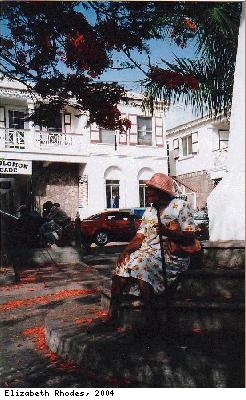The Island of Nevis
People and Places
The main town is Charlestown, a small but busy shopping area and ferry port [caption to image]
Charlestown is the main town on the island. It is a small but lively town selling all the essentials of food and clothing and has tourist shops too. Much of the food is imported from America, and is therefore quite expensive. ‘Fast foods’ are popular with younger people who have little time to cook traditional dishes such as ‘goat water’. Basic foodstuffs such as bread are produced on the island, although milk is imported from the British Virgin Islands and mainland USA. Chickens and small herds of goats and sheep roam freely throughout the island including Charlestown itself and give the town a rural feel.
Throughout the island there are trees such as mango, avocado, breadfruit, tamarind and coconut palms providing their owners with fresh fruit. There was a time when everyone on the island grew vegetables. Now the tourist industry seems to have taken precedence. There is little evidence of farming on Nevis, although the tourist industry has had the effect of encouraging small-scale market gardening to supply the hotels with fresh fruit and vegetables. Sugar cane is not grown commercially on Nevis, however it is still grown on St Kitts.
Nevis and St Kitts have fleets of fishing boats, and regularly land their catch in Basseterre on St Kitts. Some people fish from the beach with a line.
Four thousand years before Europeans arrived, the first Amerindian people living on the Caribbean islands had moved from Central and South America, travelling from one island to the next in their canoes. When Europeans came to Nevis, in the 1490s, the island was inhabited by Carib and Arawak Amerindians. Within decades these indigenous peoples had been wiped out.
Today the population of Nevis is about 11,000, mainly of mixed African and European descent, with British-, Portuguese- and Dutch-descended minorities. The islands are not far away from countries in northern South America and prove a tempting destination for immigrants from the south. Many people have the same surnames due to the post-emancipation practice when former slaves adopted the name either of their owner or plantation.
Men can expect to live to 66 and women to 71 years of age, and many live independent lives well into their late eighties. The islands are a healthy place with virtually no tropical diseases. There are four modern hospitals, three on St Kitts and one on Nevis. More serious diseases requiring specialist treatment can be referred to Puerto Rico, Barbados and the USA. There are also medical teaching facilities within the islands at the Medical University of the Americas on Nevis which has 250 students. From time to time ‘street clinics’ are set up locally to check for high blood pressure and diabetes among the population. There are 12 doctors for 11,000 people and doctors on St Kitts too. Doctors visit ‘well baby clinics’ which operate free of charge in each of the parishes. At these clinics babies are weighed and checked for normal growth and development as well as being immunised against the usual childhood diseases. Infant mortality stands at 24.2 per 1,000 live births (1994). An opthalmologist and other eye specialists from the USA visit the island two or three times a year to treat glaucoma and perform cataract operations and laser treatments.

 Nevis, ‘Our Lady of the Snows’
Nevis, ‘Our Lady of the Snows’ People and Places
People and Places Earliest settlers
Earliest settlers The arrival of the Europeans
The arrival of the Europeans Arriving on the Island today
Arriving on the Island today Education
Education Young People on the Island
Young People on the Island Government
Government Sugar and Sugar Plantations
Sugar and Sugar Plantations Churches and Religion
Churches and Religion

